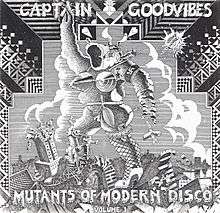Captain Goodvibes

Captain Goodvibes, a.k.a. the Pig of Steel, is the creation of Australian cartoonist Tony Edwards and became an icon of Australian surfing culture in the 1970s.
Captain Goodvibes started life as a pork chop, accidentally mutated by a chance nuclear plant explosion. According to The Encyclopedia of Surfing Goodvibes was a "hard-drinking, drug-taking, straight-talking pig with a tunnel-shaped snout.[1] The character was inspired by American cartoonist Gilbert Shelton's underground comix character, Wonder Wart-Hog, a.k.a. the "Hog of Steel."[2]
The Goodvibes cartoons were first published in Australian surfing magazine Tracks in May 1973 and appeared regularly until July 1981. Their popularity led to the publication of several Goodvibes comic books including the Whole Earth Pigalogue (1975), Captain Goodvibes Strange Tales (1975) and Captain Goodvibes Porkarama (1980), calendars, a short film Hot to Trot (co-written by Ian Watson and Tony Barrell) and a maxi-single record Mutants of Modern Disco in 1978. Captain Goodvibes also had a cinematic cameo in the 1973 surfing documentary, Crystal Voyager, appearing in a brief animated sequence during the film.
Goodvibes also starred in a radio series on Sydney radio station Double J (now Triple J) voiced by Tony Edwards and Tony Barrell.[3] In 1992 Goodvibes was named by Australia's Surfing Life magazine as one of 'Australia's 50 Most Influential Surfers'.[1]
In 2011 an anthology of the comic strip, Captain Goodvibes - My Life As A Pork Chop. 1973-1981 was published by Flying Pineapple Media.
References
- 1 2 Matt Warshaw (2005). The Encyclopedia of Surfing. Houghton Mifflin Harcourt. p. 108. ISBN 978-0-15-603251-3.
- ↑ John Jiggens. Marijuana Australiana : Cannabis Use, Popular Culture and the Americanisation of Drugs Policy in Australia, 1938-1988 (pdf). Queensland University of Technology. p. 44.
- ↑ "Radio renegade broke the mould". Sydney Morning Herald. 16 April 2011. Retrieved 24 November 2011.